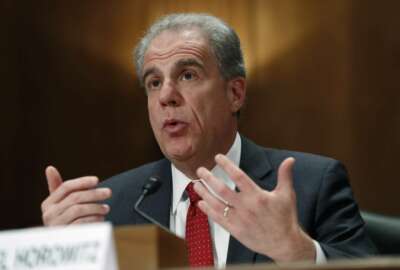

Prisons and detention facilities, in general, had some of the toughest challenges getting through the pandemic.
Best listening experience is on Chrome, Firefox or Safari. Subscribe to Federal Drive’s daily audio interviews on Apple Podcasts or PodcastOne.
Prisons and detention facilities, in general, had some of the toughest challenges getting through the pandemic. Now the Pandemic Response Accountability Committee, or PRAC, has detailed just how tough it’s been. PRAC co-chairman and inspector general of the Justice Department, Michael Horowitz, discussed incarceration during the pandemic with Federal Drive with Tom Temin.
Interview transcript:
Tom Temin: I never know what to quite call you, Michael. But you’ve got many hats on these days. But looking from the PRAC standpoint, yeah, prisons, it sounds like they were in a losing situation at the start of the pandemic, because of the nature of the fact that they’re prisons.
Michael Horowitz: That’s exactly right Tom. And it’s great to be here again with you, and probably anything you call me would be nicer than what some other people maybe have called me at times. But prisons have faced a very significant challenge. And what we did at the PRAC, at the Pandemic Response Accountability Committee was hold together reports that my office had done at DoJ — OIG — because I have authority over the Federal Bureau of Prisons. The Department of Interior, which has responsibility to manage, among other things, Native American facilities, or help build them and help with that. And of course, DHS, which has the immigration detention facilities. And so we pulled our findings together. And not surprisingly, what you saw was the pandemic hit those facilities particularly hard, and some very significant management challenges for each of those organizations, challenges related to preparation for a pandemic, which while such a pandemic hadn’t happened in a global scale in the way we’ve seen for 100 years, has actually happened in the past. I mean, prisons are prepared for tuberculosis outbreaks and flu outbreaks and other kinds of healthcare issues. So, while this was at a level not seen before, it certainly is something that you could expect facilities to at least moderately or to some extent be prepared and to have thought about.
Tom Temin: And do you think there are therefore some lessons learned on design and operation of detention facilities and prisons? Because this was an intense example of what can afflict them at any time. Are there some maybe changes that could come on a permanent basis to say the Bureau of Prisons, which has got some 150,000 inmates under its care?
Michael Horowitz: And I think one of the things you saw was facility issues exacerbating the problems. We’ve written actually in the past about challenges for the BOP with aging facilities, and facilities that were built for newer inmates that saw many more inmates during the surge in inmate influxes that occurred in the ’80s, ’90s and early 2000s. That’s turned around in the last eight, nine years. But the capacities increased dramatically, the facilities continued to age. And so what we saw in our facilities and DHS and DOI saw this from their facilities, is the prison simply weren’t built to segregate and quarantine inmates for healthcare purposes. They were built at times to create, for example, housing units to deter dangerous inmates, to put in place inmates who weren’t acting appropriately. But you’re not looking to move inmates who have a health issue into a prison quarantine setting that was really built for inmates who are dangerous, and deadly. That’s not a fair appropriate treatment of those inmates. And so, it did show of the need in the healthcare space to better prepare for healthcare outbreaks in the future.
Tom Temin: And what you found in the survey of these four different sets of prisons, Bureau of Prisons, Bureau of Indian Affairs, Marshals Service, and Immigration and Customs Enforcement, there were more or less cases and resolutions of people recovering in the same proportions. Bigger numbers for Bureau of Prisons, but the proportions of people getting sick and recovering and the death rate roughly, not totally, but more or less in proportion to the size of the inmate population that they maintained.
Michael Horowitz: That’s right. And I think what you also need to keep in mind and what we certainly found that the BOP side was the problem that occurred early on and, more than early on at some institutions, with the lack of testing. Testing is critical. Because you had so many asymptomatic inmates, and you only know to segregate and quarantine inmates if you know that they have the disease. And obviously, with COVID, as we’ve learned, many people show the signs, not right away though. And of course many people never showed signs yet were asymptomatic and were spreaders. And, we’ve commented extensively about that and that the need for better testing abilities at the BOP, and that by the way continued. The vaccine has helped, but it hasn’t resolved the problem and moved us away from the need to do testing. There are inmates who aren’t vaccinated. There are correctional officers and staff that aren’t vaccinated. There are new inmates coming in all the time. And so, that’s the thing that is a very important part of this that I don’t think was appreciated, but it’s critical to dealing with these kinds of problems going forward.
Tom Temin: We’re speaking with Michael Horowitz, chairman of the Pandemic Response Accountability Committee. He’s also inspector general at the Justice Department. So did you have recommendations then for prisons other than the fact that, yes, it would be lovely to build whole new facilities that are designed for this type of response, but that’s not going to happen realistically. Are there procedural things they can do in the meantime?
Michael Horowitz: Yes. One of the major issues is staffing. That’s again, one of the things that all of us saw, but I’ll speak for DoJ and the Federal Bureau of Prisons, the staffing shortages were quickly exacerbated by the disease and the spread of the disease. Particularly facilities that both had staffing weaknesses…shortages, whether on the correctional officer side or the healthcare side, and then had an outbreak. Because what you saw was this surge needed in staffing to deal with sick inmates, to get them to hospitals, to get them out of the facility and in medical care at hospitals, that required facilities to move non correctional officer staff, sometimes medical professionals, to do duty as correctional officer kinds of work. It’s called augmentation by the BOP. That exacerbated medical […], and so you saw this cascading problem.
Tom Temin: And that augmentation practice is not something that’s really all that favorable to begin with, because you don’t want someone who doesn’t know the ins-and-outs of being a prison correctional officer, I won’t say guard, if you don’t know how that works, that can be just fatal, really, if you’re just sort of thrust into it.
Michael Horowitz: And the whole purpose of doing this by the BOP would make sense, which is you do want all staff in an emergency to be prepared to cover all positions. But what you don’t want to do is use that as your crutch for staffing shortage, right? That’s where the problem has become. And so certainly if there was a riot in an institution, you want all staff to know how to respond to that emergency. And so having had the opportunity, on an occasion, to have served in a position, help to do that, right? But, you don’t want that as your crutch for a staffing shortage. You can’t be the replacement for getting people you need in the correctional officer position. But also in the medical side, because we’ve seen repeatedly at DoJ/OIG that there are significant medical staffing shortages at various institutions.
Tom Temin: So how have the prison operators themselves responded? What are they telling you that they plan to do?
Michael Horowitz: Well, they all supported our recommendations. And so that’s obviously the first step. Now the challenge is going to be for each of the various kinds of institutions covered by our report, whether they are on the Marshals Service side, at the BOP side, on the immigration side, the Native American reservation side, is now putting in place a process by which they can both ask for the funding they need, in many instances, to be able to give the staffing abilities that they need. And then carefully thinking about it from a management standpoint. But one of the things we’ve found at DoJ is the challenge at BOP is being able to report out at each institution, there are 122 federal prisons on the DoJ side, and knowing where are we short, and what do we need to fill those shortages? And that’s a problem that we’ve seen from a management standpoint repeatedly at DoJ/BOP.
Tom Temin: So basically, the pandemic for the prison operators, and I guess for so many federal facilities, really either was magnified by poor management practices, or maybe mitigated by really excellent management practices in general.
Michael Horowitz: And certainly in some of the institutions we reported on, we saw strong, immediate responses, and recognizing the challenges and managers managing with the tools they had available to them in environments that were inherently challenging. Unfortunately we saw in many instances that didn’t occur or couldn’t occur, because of the inherent challenges people were facing. And why it was so important for the PRAC, for us to pull this together across agencies, was to demonstrate, to show to the public this wasn’t isolated in one prison or one facility or even one agency. But it’s really something that we needed to think of from whole-of-government perspective.
Tom Temin: And what’s next to come out from PRAC? What other sector can we expect next?
Michael Horowitz: We have several programs going forward. We’re looking at what I’ll colloquially referred to as double-dipping, whether individuals were able to benefit from multiple programs improperly at the same time. So we’re looking at that issue. We’re going to be looking at an impact, doing some case studies on impact. We’re going to look at various communities, small cities, rural communities, and Native American communities, and try and understand from a case study standpoint, how all of the money that has flowed down to those communities impacted the community, and what could have been done better. And I’ll encourage listeners to go to our website, pandemicoversight.gov. You can see how the money has flowed down to the zip code level. I found it interesting for my own standpoint looking where I grew up, and going to the zip code from where I grew up and see some of the businesses that got money there and asking, “well, why did they get the money and others maybe didn’t?” And I think that’s something that we want to try and report out on to the public.
Tom Temin: Michael Horowitz is chairman of the Pandemic Response Accountability Committee and inspector general of the Justice Department. As always, thanks so much.
Michael Horowitz: Always great to be here, Tom. Thank you.
Copyright © 2025 Federal News Network. All rights reserved. This website is not intended for users located within the European Economic Area.
Tom Temin is host of the Federal Drive and has been providing insight on federal technology and management issues for more than 30 years.
Follow @tteminWFED



